The UBI Center’s 2020 year in review
Our work, studies from other researchers, and the biggest UBI news from the past year
2020 has been a devastating year. Covid-19 has killed nearly two million people worldwide, thrown tens of millions into extreme poverty, and disrupted virtually every aspect of society.
The pandemic has also changed perceptions of social protection programs. With millions unable to work safely, populations are more open to unconditional cash transfers, and governments have delivered.
Researchers have continued to investigate how societies could adopt universal basic income policies, and fueled by our biggest growth year (we now have ten researchers), we’ve contributed with policy simulations and evidence reviews.
Following up on our 2019 review, this post summarizes our work from the past year, along with studies from other researchers and the biggest UBI news.
UBI Center research
Policy simulation
Our bread-and-butter simulations of UBI policy became more targeted, robust, and policy-relevant throughout 2020. Our simulations showed how UBI would shrink black-white poverty and wealth gaps, how it would affect people with disabilities, Indigenous Americans, and Veterans, and how a child allowance would cut child poverty.
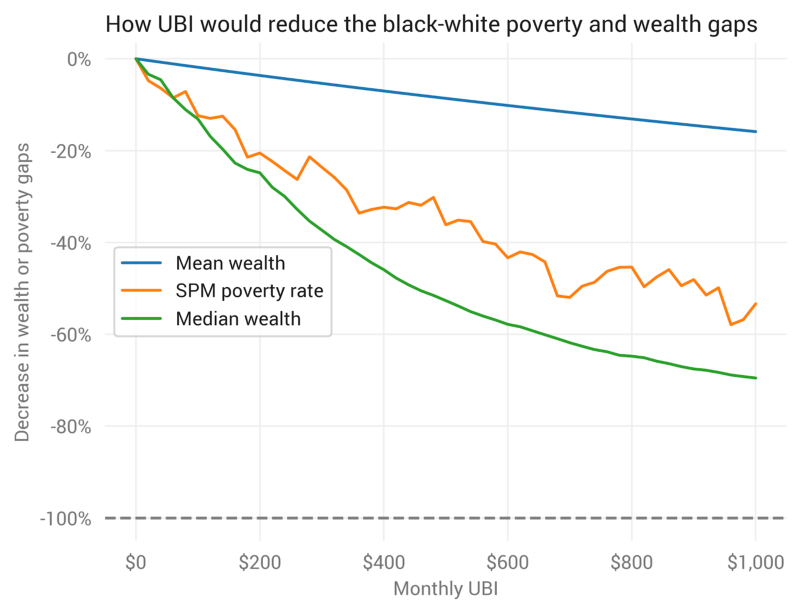
Our first paper of the Covid era showed how different UBI policy designs could stabilize the poverty rate amid income-lowering recessions, and our latest analysis showed how replacing our existing tax code with a flat income tax could be made progressive with a UBI.
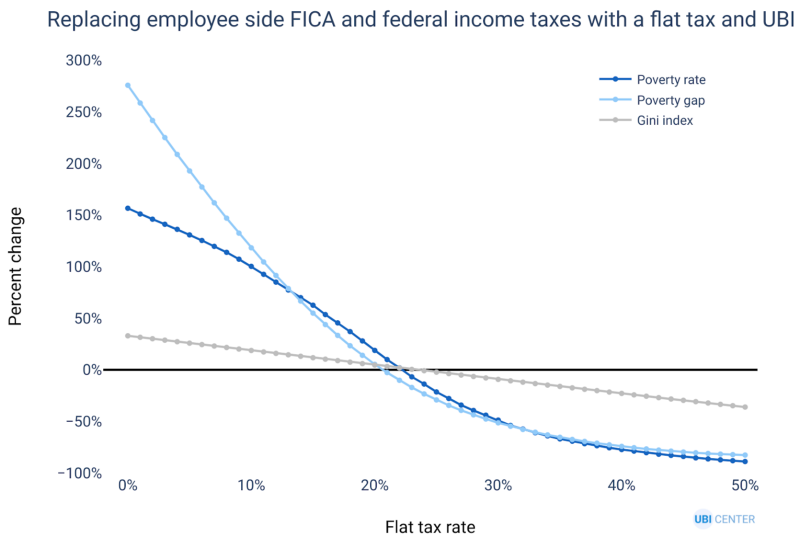
We also compared UBI to other policies (given a fixed budget), finding that it would be more progressive than canceling student debt, and likely more progressive than expanding additional US unemployment benefits.
Other research
In 2020, we expanded our research portfolio beyond policy simulation to other topics related to UBI. We produced novel analyses and context of a cash transfer experiment targeting Canadians experiencing homelessness. To inform Democratic primaries, we summarized candidates’ stances on UBI. And we tracked and summarized all 27 emergency cash transfer proposals in the US (see coverage of our tracker in The Balance).
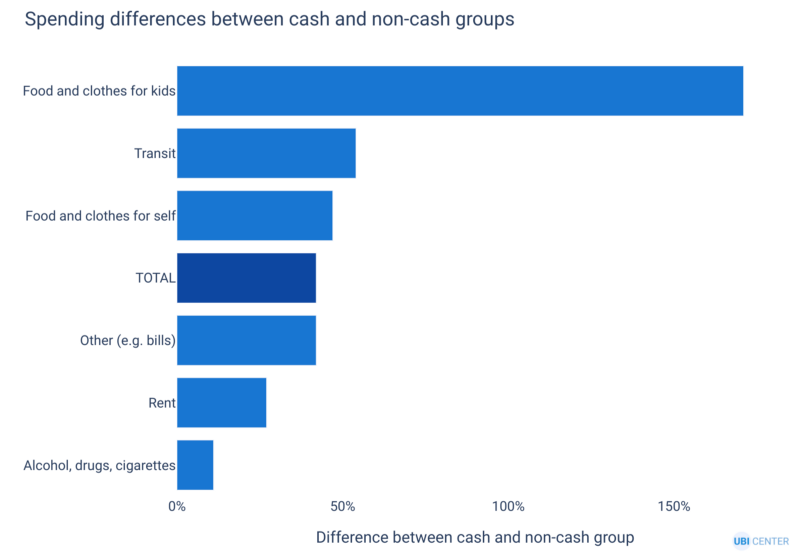
We also integrated deeper non-simulation analysis into simulation projects. Our child allowance project summarized dozens of papers on the impacts of child poverty, while our flat tax project included original statistical analysis of tax and transfer policies associated with inequality reduction among OECD countries.
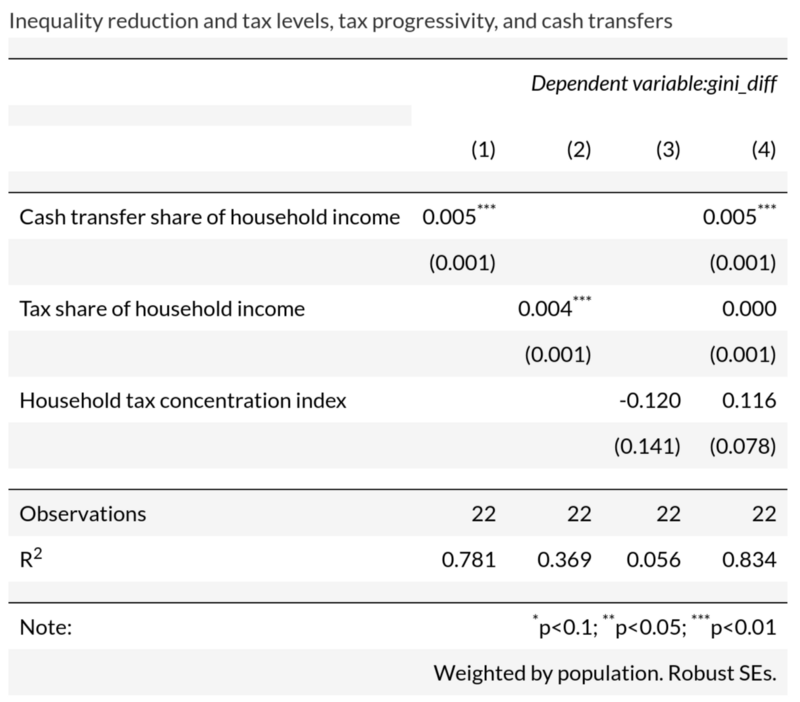
Open source contributions
We’re the first and only economic policy think tank to open-source all of our work, and we take pride in using and contributing to open source software for economic policy research. This year, the Policy Simulation Library accepted two of our Python packages — microdffor analyzing survey data, and openfisca-uk for simulating UK economic policy — to its catalog, adding two of our staff to its leadership council. We also created new incubating models to work with the US Survey of Consumer Finances and the UK Family Resources Survey. Our researchers contributed to several open source projects on GitHub, from improving documentation in PSL’s Tax-Calculator and OG-USA economic models to enhancing Python’s support for producing publication-grade regression tables. Finally, we made our own research more open and reproducible by moving most content to Jupyter-Book, which shows hideable code within the interactive web document.
Outreach
We shared our research in numerous forums: op-eds in The Hill on our unemployment benefit and child allowance analyses; presentations at the Tax Economists Forum, the PyData Global conference, and Social Giving; andYouTubechannels. We also launched our own newsletter and YouTube channel.
Plans for 2021
2021 promises to be an even bigger year, with upcoming simulations of UBI in the UK, benchmarks of UBI against competing policies, macroeconomic and behavioral effects, interactive tools, events and partnerships, a new website, and more.
External research
Reviews and tools
A Stanford Basic Income Lab UBI study cross-synthesis affirmed that UBI-type programs alleviate poverty, improve health and education outcomes, while having minimal effects on labour market participation. It nominated understanding of the “tradeoffs between UBI and other programs,” and particularly the impact of “financing a UBI through new revenue streams or diversions from existing programs” as a key gap in the existing research — precisely the gap our research aims to close.
The cash transfer evidence base also became more navigable with the creation of new tools to access studies that address the impact of cash transfer. The Basic Income Lab expanded its platform, providing new visualizations that allow users to dive into studies related to UBIs categorized by outcome. GiveDirectly created a Cash Research Explorer that enables users to filter and sort a large database of existing cash transfer studies.
Policy simulations
We welcomed not being the only UBI simulators in town, with studies on various policy designs being conducted around the world.
In the US, Columbia University’s Center on Poverty & Social Policy released a series of policy briefs on how a guaranteed income would affect poverty, comparing recent policy proposals and addressing child inclusion in a carbon tax and universal dividend program. A simulation from Brookings found 10% VAT could reduce the debt by $2.9 trillion over 10 years, boost means-tested programs and Social Security, and provide a UBI at 20% of the poverty line, raising bottom-quintile income by 17%. And a dynamic macro model found that most Americans would prefer UBI today, but future generations would not.
An Australian study found that an “affluence-tested” UBI would reduce inequality and poverty to levels similar to Nordic welfare states, requiring an increase in taxation to approximately the OECD average. Other simulations in Gulf states and the UK showed similarly egalitarian results.
Optimal taxation papers continued to study policies that rebate excess revenue as UBI. One such paper found that optimal tax rates and welfare rise when incorporating uncertainty around labor responses, and another from NBER found that “a uniform flat tax on capital and labor income combined with a lump-sum transfer is nearly optimal.”
Resilience and adherence: COVID-19
In a difficult year in which COVID-19 brought economies around the world to a standstill, we learned more about how cash transfers can create resilience to income shocks. The continuation of GiveDirectly’s UBI experiment in Kenya during the COVID-19 crisis offered the opportunity to estimate the impact of unconditional cash transfers to poor families. As the first true UBI experiment in history — guaranteeing payments that meet basic needs for each member of randomly selected villages for up to 12 years — its first results deserve special attention.
Banerjee et al. found that the UBI, which began in 2016, significantly reduced recipient hunger, sickness and depression in spite of the pandemic, though with modest effect sizes. It also reduced hospital visits and decreased social interactions, indicating that access to a UBI offered people a greater capacity to follow public health recommendations about social distancing and thereby likely reduced contagion rates. While recipients lost the income gains from starting non-agricultural enterprises during the pandemic, they suffered smaller increases in hunger, indicating that the UBI induced recipients to accept more income risk by mitigating the effects of adverse income shocks.
Mental health
This year, numerous studies shed light on how cash transfers can reduce stress, improve self-reported well-being and enable participants to make more rational long-term economic decisions.
Finland’s basic income experiment, which was carried out in 2017–18, reported this year that basic income recipients were more satisfied with their lives, experienced less mental strain and had a more positive perception of their economic welfare.
In a developing context, Molotsky and Handa found that national cash transfers in Malawi reduced stress and improved positive affect among recipients; these psychological effects directly impacted on economic decision-making, encouraging recipients to make more long term decisions.
Haushofer et al., 2020b found that cash transfers in rural Kenya outperformed more costly psychotherapy programs both in economic and psychological well-being outcomes, and that a combination of cash transfers and psychotherapy was no more effective than cash alone.
That said, Haushofer et al., 2020a found that in Nairobi, free health insurance outperformed a uniform cash transfer of the same value in reducing self-reported stress and cortisol levels, though the most conservative statistical bounds render the difference statistically insignificant. It found no effect of either program on other economic and health outcomes.
A large-scale meta-analysis found that cash transfers improved self-reported subjective well-being and mental health and that the higher the transfer, the greater the impact. Unconditional cash transfers outperformed conditional cash transfers. And a review in Science Magazine found that “cash transfers and broader antipoverty programs reduce depression and anxiety in randomized trials […] poverty experienced in childhood and in utero [results] in impaired cognitive development and adult mental illness.”
Other effects of cash transfers
The voluminous literature on cash transfers continued to grow rapidly in 2020. Here are a sample of influential papers from the year.
In India, a multifaceted intervention that included a cash transfer for 30 to 40 weeks improved consumption, food security, income, and health for up to a decade. In Mexico, cash transfers halved homicides on hot days by reducing stress and increasing air conditioning. In Rwanda, cash transfers outperformed a USAID workforce readiness program on key outcomes like income.
In the US, the 1990s retraction of cash assistance to poor mothers worsened child-parent interactions (the effect was not traced to changes in the mother’s labor supply). The Alaska Permanent Fund Dividend increased fertility (births per woman) by 13 percent after its introduction, mostly among women aged 20 to 44.
Conditionality and targeting
New evidence from the Kenya Cash Transfer Programme for Orphans and Vulnerable Children for at-risk children shows that enforcing compliance with health conditions with monitoring and fines doesn’t improve program effectiveness compared to ‘labelling’ transfers — providing suggestions for how recipients should use transfers. The study also showed that fines had regressive impacts. Among the poorest transfer recipients, fines for noncompliance were associated with a significant decline in non-food consumption.
Researchers also quantified the cost of administrative burdens for SNAP recipients in the US, and the New York Times centered this research in an interactive story. The Jain Family Institute published two papers in its series on guaranteed income, describing implementation of guaranteed income in the US and a framework for considering what programs the guaranteed income could suitably replace.
Polls
Pollsters asked people from all over the world how they felt about UBI and cash transfers, and the timing of these polls showed how Covid-19 affected sentiments toward the welfare state.
The first polls came from the US, where in February, 63% of people aged 18–36 supported a universal basic income of $1,000 per month for adults. Data for Progress found that net support for sending each American a check for $1,000 rose from -15 to +32 between March 2 and March 17, when the gravity of the pandemic became apparent. Also in March, Data for Progress found that Americans prefer ongoing payments to one-time payments by a 38-point margin, and between monthly payments of (a) $2,000/adult + $1,000/child and (b) $1,000/adult, voters prefer the larger amount by a 15-point margin.
Polls outside the US found majority support for the policy, too. A March poll found that 71% of Europeans support UBI; an April poll found that 51% of Brits supported it; also in April, 62% of Manitoba, Canada residents supported UBI; and as of October, 58% of Australians supported it.
News
Calls for UBI
Government leaders and other influential people and organizations called for UBI pilots and policies, especially relating to (but not limited to) the Covid-19 pandemic.
Perhaps the most forceful voices came from the UK. The Liberal Democrats (the third largest party, which received 12 percent of votes in 2019) endorsed UBI in September, and in October, over 500 MPs, peers and councillors requested that the Chancellor support UBI trials. Throughout the year, several councils campaigned to launch UBI pilots in their areas, including Liverpool, Brighton, Leeds, Norwich and Belfast.
Leaders in Canada have been similarly enthusiastic. Canada has a rich history of unconditional cash transfers: they created the Mincome experiment in the 1970s, a UBI pilot in the province of Ontario (prematurely cancelled in 2019), a generous child benefit, and the CERB program providing CAD 2,000 (USD 1,570) per month through September to people who’d lost employment due to Covid-19. In July, British Columbia Senator Yuen Pau Woo suggested testing UBI, and in the same month, the Senate national finance committee released a report highlighting the need for UBI. In September, a coalition of nearly 4,000 individuals and organizations called on the federal government to work toward UBI.
In the United States, several members of Congress called for one-time and recurring unconditional payments amid Covid-19 (see our tracker), including a proposal for $2,000 monthly checks per person from Senator Bernie Sanders and Vice President-elect Kamala Harris. The one-time relief payments of $1,200 from March were renewed at $600 in the December bill, along with flat payments of $300 per week for unemployed people (down from $600 from April through July). The governor of Alaska also proposed increasing the Alaska Permanent Fund Dividend from its normal value of $1,000-$3,000 to $5,000 due to the coronavirus.
Pro-UBI US voices were elevated in 2021, too. In April, Jack Dorsey created a $1 billion philanthropic fund from his holdings in Square; the fund has since grown to $3.7 billion, of which he’s spent $330 million, including $44 million for UBI pilots. Pro-UBI Elon Musk became the world’s second wealthiest person in December. Andrew Yang, who centered his presidential campaign on UBI (we publishedthreestudies and a calculator on his plan in 2019), ended his presidential campaign in February, but he is now the favorite for New York City’s 2021 mayoral race.
Leaders in various other countries have supported UBI as well. In March, one of Australia’s largest unions called for a guaranteed income throughout the pandemic, structured as a job guarantee plus AUD 740 (USD 725) per week for people who don’t participate in the job guarantee program. In South Africa, the governing party highlighted the need for a UBI, but plans for a 2020 policy were scrapped in July. Finally, the United Nations Economic Commission for Latin America and the Caribbean and UN Development Program’s Asia-Pacific bureau have called for UBI.
Guaranteed income initiatives
In addition to one-time payments and ongoing payments to unemployed people like those in the US and Canada, several governments and nonprofits are sending regular cash payments to broad sets of people without requiring work history.
In the US, Mayors for a Guaranteed Income — which now includes over 30 mayors — is driving a number of new philanthropically-funded guaranteed income pilots, including in Compton, and established the Center for Guaranteed Income Research at the University of Pennsylvania. San Francisco and Long Beach will also both give basic incomes to artists (see our comments in coverage of the San Francisco program). But the nonprofit GiveDirectly has already distributed the most — since March, they’ve transferred $1,000 to each of 134,000 SNAP recipients, with 99% efficiency and an average of two days between enrollment and first payment.
GiveDirectly also delivered transfers to over 500,000 recipients outside the US, creating new contact-free payment models and adding new programs. For example, they provided USAID-funded educational stipends of $50 to 37,000 12th-graders in every high school in Liberia, and applied machine learning to identify and pay extremely poor households in Togo.
Brazil is expanding its Bolsa Familia cash transfer into a new program called Renda Cidada (“citizen income”), and Bogota, Colombia, is giving cash and food aid to over 700,000 households. Spain introduced a minimum income program that intended to benefit over 2 million individuals, but implementation challenges are slowing it down.
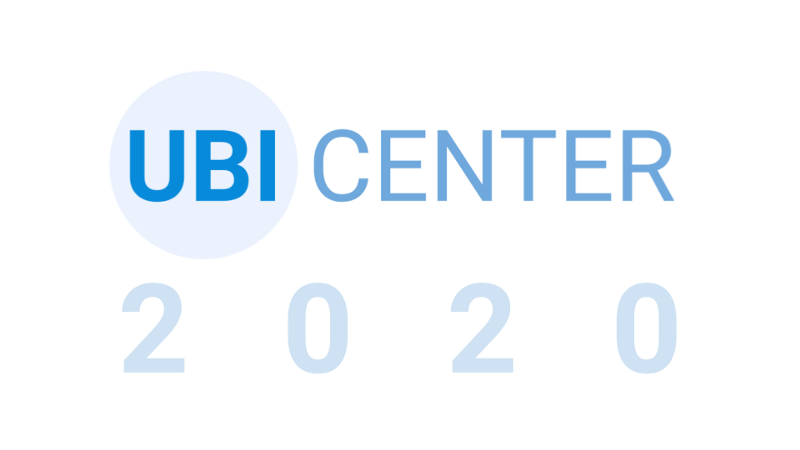
On most measures, 2021 has a low bar to clear to outdo 2020. Given this array of studies, UBI research might not be one of those measures, but we expect even more simulations, randomized controlled trials, meta-analyses, and new programs to inform UBI policy design and how UBI compares to the status quo and alternatives. To follow our research on these fronts, subscribe to our newsletter or follow us on social media.
Happy New Year!
The UBI Center team
Subscribe to the UBI Center
Get the latest posts delivered right to your inbox

